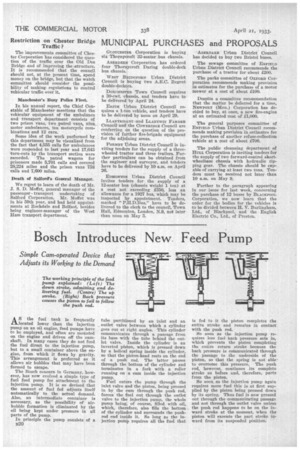Bosch Introduces New Feed Pump
Page 34

If you've noticed an error in this article please click here to report it so we can fix it.
Simple Cam-operated Device that Adjusts its Working to the Demand
AS the fuel tank is freqtiently ,located lower than the injection pump on an oil engine, feed pumps have to be employed, and often are mounted on the engine and driven off the camshaft. In many cases they do not feed the fuel direct to the injection pump, but to a small container above the engine, from which it flows by gravity. This arrangement is preferred as it allows air bubbles that may have been formed to escape.
The Bosch concern in Germany, however, has now evolved a simple type of fuel feed pump for attachment to the injection pump. It is so devised that the amount of fuel fed adjusts itself automatically to the actual demand. Also, no intermediate container is necessary, as the possibility of airbubble formation is eliminated by the oil being kept under pressure in all parts of the Pump.
In principle the pump consists of a
tube partitioned by an inlet and an _ outlet valve between which a cylinder goes out at right angles. This cylinder communicates through a passage from its base with the tube behind the outlet valve. Inside the cylinder is an inverted piston, which is pressed down by a helical spring inside the cylinder, so that the piston-head rests on the end of a push rod. The latter passes through the bottom of the cylinder and terminates in a fork with a roller running on a cam inside the injection pump.
Fuel enters the pump through the inlet valve and the piston, being pressed in by the cam through the push rod, forces the fuel out through the outlet valve to the injection pump, the whole pump being, of course, filled with oil, which, therefore, also fills the bottom of the cylinder and surrounds the pushrod end inside it. So long as the injection pump requires all the fuel that
is fed to it the piston completes the entire stroke and remains in contact with the push rod.
So soon as the injection pump requires less fuel back pressure sets in, which prevents the piston completing the entire return stroke because the back pressure is communicated through the passage to the underside of the piston, so that the spring is not able' to overcome this pressure. The pusli rod, however, continues its complete stroke as before and, therefore, parts from the piston.
So soon as the injection pump again requires more fuel this is at first supplied by the piston being pressed down by its spring. Thus fuel is now pressed out through the communicating passage and not through the outlet valve unless the push rod happens to be on the inward stroke at the moment, when the piston will execute the part stroke inward from its suspended position.




























































































